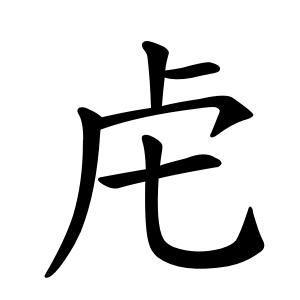虍
- tiger;
- pattern of tiger fur;
It is called "호피무늬 호" in Korean, which literally means "tiger stripe pattern."
Etymology
According to the Shuowen Jiezi (説文解字 shuōwén jiězì), the character 虍 represents the spotted pattern of a tiger’s skin and is described as a character that imitates this pattern.
Research on ancient characters explains that the entire character 虎 depicts a tiger viewed from the side, and 虍 specifically represents the tiger’s head and front legs.
Usage in Korean
When used as a radical (semantic component), it generally conveys meanings related to tigers and typically appears in a form that encloses the top and left sides of a character.
Additionally, there are cases where it attaches in the same form as the character 虎 itself, as seen in characters like 彪 and 號.
虍
호피무늬
호
hopi munui
ho
Kangxi radical:141
Strokes:6
Unicode:U+864D
Cangjie input:
- 卜心 (YP)
Composition:
- ⿸⿱ ⺊ ⿱ 乛 丿 七
